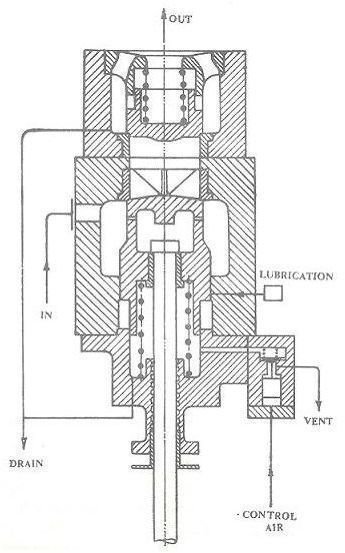Starting air admittance valve for main marine engine of a ship
Introduction
We have learnt how compressed air is used for various purposes on board ships, and its use in solving starting problems related to main and auxiliary engines. We have seen the full layout of the compressed air starting system. Now it is time to take an individual look at the various components of this system and we will study the master air starting valve of a marine engine in this article.
Master Air Admittance Valve
If you remember the air starting system from our previous article, you will notice that a main valve is fitted at the entrance to the main air starting line from the air bottles. This valve has to fulfill the following functions
- To supply pressurized air from the bottles to the engine cylinder via individual cylinder valves
- To ensure that once the engine has started it cuts off the air supply
- To ensure that no products of combustion pass over to the bottle side
The last point is very important since once the engine starts firing, the cylinders are full of hot gases and if these gases find their way across to the main air storage tanks or bottles, the result could be anybody’s guess. It could cause a huge explosion and could lead to damage of life and property and might endanger the ship or start an engine room fire.
In order to ensure this sort of safety, a non-return valve is incorporated inside the starting air valve so that there is only one way passage for the air from the bottle to the engine cylinders but not the other way round. This is all explained in the next section in more detail.
Construction & Working
The construction of the master air starting stop valve is shown clearly in the diagram below which shows the cut section of the valve and all the internal parts and passages are clearly shown and legibly marked for the benefit of the readers.
The inlet and outlet for the starting air are shown in the diagram as well as the drain and the control air path. It must be understood that there is a difference between the control air and the starting air. The starting air actually goes inside the cylinders and makes the engine start, while the control air is used to control the timing of the main starting air and cutting it off at an appropriate time.
The arrangement consists of a spring loaded non-return valve which is used for safety purpose and to prevent blow back of the gases to the engine aided with the flame trap which is also provided there.
There is also an arrangement to operate this valve manually in case it does not open or close automatically due to some problem. Now suppose the control air line suddenly gets faulty so the starting air pressure could keep the valve open, but because of the stop valve it gets shut when blow back gases try to escape to the other side.
It is important to note that the main starting air line is kept in vented position when not in use. This is important to prevent any build up of pressure due and also to remove any condensate in the line which could cause knocking in the line when the compressed air at high pressure whizzes past it. Next to the starting air master valve are the individual cylinder valves which deal with different cylinders, as well shall see in our next article.
Image Credits
Complete Guide to Diesel Marine Engines by John Flemming
